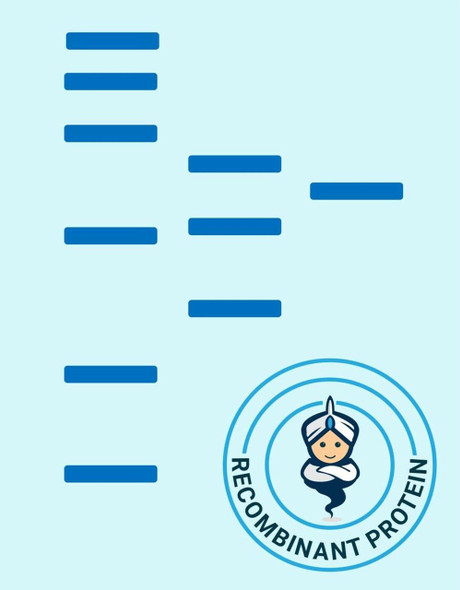Cytokines Recombinant Proteins
Human 4 1BBL Recombinant Protein (RPPB0987)
- SKU:
- RPPB0987
- Product Type:
- Recombinant Protein
- Species:
- Human
- Uniprot:
- P41273
- Research Area:
- Cytokines
Description
| Product Name: | Human 4 1BBL Recombinant Protein |
| Product Code: | RPPB0987 |
| Size: | 20µg |
| Species: | Human |
| Target: | 4 1BBL |
| Synonyms: | CD137L, CD137-L, 4-1BBL, 4-1BB Ligand, TNFSF9, Tumor Necrosis Factor (ligand) Superfamily Member 9. |
| Source: | Escherichia Coli |
| Physical Appearance: | Sterile Filtered colorless solution. |
| Formulation: | Recombinant 4-1BBL solution (1mg/ml) contains 20mM Tris-HCl buffer pH-8, 100mM NaCl and 20% glycerol. |
| Stability: | Store at 4°C if entire vial will be used within 2-4 weeks. Store, frozen at -20°C for longer periods of time. For long term storage it is recommended to add a carrier protein (0.1% HSA or BSA).Avoid multiple freeze-thaw cycles. |
| Purity: | Greater than 95.0% as determined by SDS-PAGE |
| Amino Acid Sequence: | MRGSHHHHHH GMASMTGGQQ MGRDLYDDDD KDRWGSHMRE GPELSPDDPA GLLDLRQGMF AQLVAQNVLL IDGPLSWYSD PGLAGVSLTGGLSYKEDTKE LVVAKAGVYY VFFQLELRRV VAGEGSGSVS LALHLQPLRS AAGAAALALT VDLPPASSEA RNSAFGFQGR LLHLSAGQRL GVHLHTEARA RHAWQLTQGA �TVLGLFRVTP EIPAGLPSPR SE |
4-1BBL is a transmembrane cytokine that is part of the tumor necrosis factor (TNF) ligand family. 4-1BBL is a bidirectional signal transducer that performs as a ligand for TNFRSF9, which is a costimulatory receptor molecule in T lymphocytes. TNFSF9 and its TNFRSF9 take part in the antigen presentation development and in the generation of cytotoxic T cells. 4-1BBR is absent from resting T lymphocytes but rapidly expressed upon antigenic stimulation. TNFSF9 reactivates anergic T lymphocytes as well as promoting T lymphocyte proliferation. 4-1BB Ligand is needed for the optimal CD8 responses in CD8 T cells. 4-1BBL is expressed in carcinoma cell lines, and is thought to be involved in T cell-tumor cell interaction. 4-1BBL is expressed by activated B cells, macrophages, dendritic cells, activated T cells, neurons and astrocytes. The interaction of 4-1BB with TNFRSF9 strongly regulates immunity and has been proposed to preferentially control T cell responses based on studies in various murin
TNFSF9 Human Recombinant fused to 37 amino acids His tag at N-terminus produced in E.Coli is a single, non-glycosylated polypeptide chain containing 222 amino acids (71-254 a.a.) and having a molecular mass of 23.8 kDa. The TNFSF9 37 aa His tag fusion protein is purified by proprietary chromatographic techniques.
| UniProt Protein Function: | TNFL9: Cytokine that binds to TNFRSF9. Induces the proliferation of activated peripheral blood T-cells. May have a role in activation-induced cell death (AICD). May play a role in cognate interactions between T-cells and B-cells/macrophages. Belongs to the tumor necrosis factor family. |
| UniProt Protein Details: | Protein type:Apoptosis; Cell cycle regulation; Cytokine; Membrane protein, integral Chromosomal Location of Human Ortholog: 19p13.3 Cellular Component: plasma membrane Molecular Function:receptor binding; tumor necrosis factor receptor superfamily binding Biological Process: apoptosis; cell proliferation; cell-cell signaling; positive regulation of activated T cell proliferation; positive regulation of cytotoxic T cell differentiation; signal transduction; tumor necrosis factor-mediated signaling pathway |
| NCBI Summary: | The protein encoded by this gene is a cytokine that belongs to the tumor necrosis factor (TNF) ligand family. This transmembrane cytokine is a bidirectional signal transducer that acts as a ligand for TNFRSF9/4-1BB, which is a costimulatory receptor molecule in T lymphocytes. This cytokine and its receptor are involved in the antigen presentation process and in the generation of cytotoxic T cells. The receptor TNFRSF9/4-1BB is absent from resting T lymphocytes but rapidly expressed upon antigenic stimulation. The ligand encoded by this gene, TNFSF9/4-1BBL, has been shown to reactivate anergic T lymphocytes in addition to promoting T lymphocyte proliferation. This cytokine has also been shown to be required for the optimal CD8 responses in CD8 T cells. This cytokine is expressed in carcinoma cell lines, and is thought to be involved in T cell-tumor cell interaction.[provided by RefSeq, Oct 2008] |
| UniProt Code: | P41273 |
| NCBI GenInfo Identifier: | 728739 |
| NCBI Gene ID: | 8744 |
| NCBI Accession: | P41273.1 |
| UniProt Secondary Accession: | P41273,Q2M3S2, |
| UniProt Related Accession: | P41273 |
| Molecular Weight: | 27kDa |
| NCBI Full Name: | Tumor necrosis factor ligand superfamily member 9 |
| NCBI Synonym Full Names: | TNF superfamily member 9 |
| NCBI Official Symbol: | TNFSF9�� |
| NCBI Official Synonym Symbols: | CD137L; TNLG5A; 4-1BB-L�� |
| NCBI Protein Information: | tumor necrosis factor ligand superfamily member 9 |
| UniProt Protein Name: | Tumor necrosis factor ligand superfamily member 9 |
| UniProt Synonym Protein Names: | 4-1BB ligand; 4-1BBL |
| Protein Family: | Tumor necrosis factor ligand superfamily |
| UniProt Gene Name: | TNFSF9�� |






